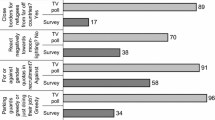Abstract
We studied undercoverage and nonresponse in a telephone survey among the population of the City ofGroningen, the Netherlands. The original sample, drawn from the municipal population register,contained 7000 individuals. For 37 percent of them, the telephone company was unable to produce a validtelephone number. Of those with a known telephone number, 49 percent did not answer the telephone orrefused to cooperate. As a result, the final respondents comprised merely 32 percent of the originalsample. To study distributional bias, we used individual-level data compiled from municipal records asour benchmark. Bivariate as well as multivariate analyses showed the undercoverage to be stronglyrelated to all sociodemographic variables studied, except gender. Nonresponse was related to age, countryof origin, marital status, and household size and composition, but not to gender, unemployment, socialassistance benefit, and education. Both undercoverage and nonresponse contributed to a strong middleclass bias in the final data set: middle-aged and older, economically secure people, of Dutch origin andliving with others in a household are overrepresented, while persons in disadvantaged and marginalpositions, such as the young, people of foreign stock, the unemployed, persons depending on publicincome support and singles are underrepresented.
Similar content being viewed by others
References
Ball, D.W. (1968). Toward a sociology of telephones and telephoners. In: M. Truzzi (ed.), Sociology and Everyday Life. Englewood Cliffs, N.J.: Prentice-Hall, pp. 59–75.
Baruch, Y. (1999). Response rate in academic studies — A comparative analysis. Human Relations 52: 421–438.
Brunner, J. A. & Brunner, G. A. (1971). Are voluntarily unlisted telephone subscribers really different? Journal of Marketing Research 8: 121–124.
De Leeuw, E. D. & Hox, J. J. (1998). Nonresponse in surveys: Een overzicht. Kwantitatieve Methoden 57: 31–53.
Ellemers, J. E. & Vaillant, R. E. F. (1985). Indische Nederlanders en gerepatrieerden. Muiderberg: Coutinho.
Engbersen, G. (1990). Publieke Bijstandsgeheimen: Het ontstaan van een onderklasse in Nederland. Leiden/Antwerpen: Stenfert Kroese.
Engbersen, G. & Vervaart, J. (1993). Geheime nummers: De Nederlandse onderklasse houdt zich gedekt. Intermediair 29(35): 25–29.
Galtung, J. (1967). Theory and Methods of Social Research. London: Allen & Unwin.
Goyder, J. (1987). The Silent Minority: Nonrespondents on Sample Surveys. Cambridge: Polity Press.
Groves, R.M. (1987). Research on survey data quality. Public Opinion Quarterly 51: S156–S172.
Groves, R. M. (1990). Theories and methods of telephone surveys. Annual Review of Sociology 16: 221–240.
Hagendoorn, L. (1995). Intergroup biases in multiple group systems: The perception of ethnic hierarchies. European Review of Social Psychology 6: 199–228.
Hartmann, P. H. & Schimpl-Neimanns, B. (1992). Sind Sozial-strukturanalysen mit Umfragedaten möglich?: Analysen zur Repräsentativität einer Sozialforschungsumfrage. Kölner Zeitschrift für Soziologie und Sozialpsychologie 44: 315–340.
Hox, J. J. & De Leeuw, E. D. (1994). A comparison of nonresponse in mail, telephone, and face-to-face surveys: Applying multilevel modelling to meta-analysis. Quality and Quantity 28: 329–344.
Keeter, S. (1995). Estimating telephone noncoverage bias with a telephone survey. Public Opinion Quarterly 59: 196–217.
Kerssemakers, F. A. M., De Mast, F. A. C. & Remmerswaal, P. W. M. (1987). Computer Assisted Telephone Interviewing, some response findings. CBS Select 4. Voorburg/Heerlen: CBS, pp. 119–131.
Kersten, H. M. P. & Moning, H. J. (1985). Differences in estimates due to changes in methods of data collection. Kwantitatieve Methoden 19: 31–47.
Maas, C. & De Heer, W. (1995). Response developments and the field work strategy. Bulletin de Méthodologie Sociologique No. 47 (June): 36–51.
O'Neill, M. J. (1979). Estimating the nonresponse bias due to refusals in telephone surveys. Public Opinion Quarterly 43: 218–232.
Rutter, D. R. (1987). Communicating by Telephone. Oxford, etc.: Pergamon.
Smith, T. W. (1990). Phone home? An analysis of household telephone ownership. International Journal of Public Opinion Research 2: 369–390.
Steeh, C. (1981). Trends in nonreponse rates. Public Opinion Quarterly 45: 40–57.
Tesser, P. T. M., Merens, J. G. F. & Van Praag, C. S. (1999). Rapportage minderheden 1999. Den Haag: Sociaal en Cultureel Planbureau.
Vermeulen, H. & Penninx, R. (eds.) (1994). Het democratisch ongeduld: De emancipatie en integratie van zes doelgroepen van het minderhedenbeleid. Amsterdam: Het Spinhuis.
Wunderink, S. R. & Van Benthem, M. (2000). Bel-irritaties en representativiteit. Economisch-Statistische Berichten 85: 353–355.
Author information
Authors and Affiliations
Rights and permissions
About this article
Cite this article
Van Goor, H., Rispens, S. A Middle Class Image of Society. Quality & Quantity 38, 35–49 (2004). https://doi.org/10.1023/B:QUQU.0000013237.59150.ff
Issue Date:
DOI: https://doi.org/10.1023/B:QUQU.0000013237.59150.ff




